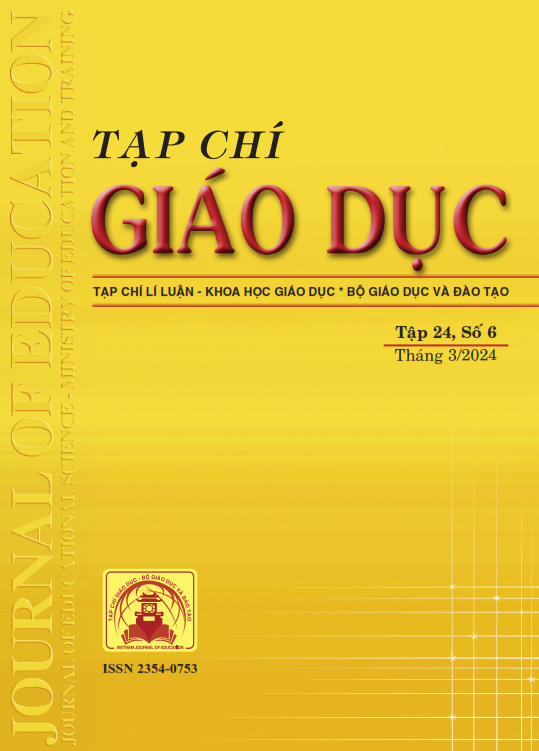Phát triển năng lực mô hình hóa toán học cho học sinh trong dạy học giải bài toán thực tiễn (Toán 10)
Tóm tắt
According to the 2018 General Education Curriculum, mathematical modeling competency is one of the components of mathematical competency that needs to be formed and developed for students. Mathematical modeling competency helps students solve practical problems by using mathematical models to convert practical problems into mathematical problems. This study presents a mathematical modeling process in teaching practical problems solving and illustrates the process in teaching practical problems solving in the Math 10 program at Phu Nhuan High School, Ho Chi Minh City. The experimental teaching results show that solving practical problems through the mathematical modeling process has developed elements of mathematical modeling competency for students.
Tài liệu tham khảo
Barreto, A. C. (2010). Reference Center for Mathematical Modeling in Teaching. Brazilian Precursors.
Blomhoj, M., & Jensen, T. (2007). What’s all the fuss about competencies? Modelling and Applications in Mathematics Education, 14, 45-56.
Blum, M., & Jensen, T. H. (2007). What’s all the fuss about competencies? In W. Blum, P. L.Galbraith, H. Henn, M. Niss, (Eds): Modelling and Applications in Mathematics Education (ICMI Study 14), 45-56, Springer.
Blum, W., & Leiss, D. (2007). How do students and teachers deal with mathematical modeling problems? In book: Mathematical Modelling (pp. 222-231). Education engineering and economics Chichester: Horwood Publishing.
Bộ GD-ĐT (2018). Chương trình giáo dục phổ thông môn Toán (ban hành kèm theo Thông tư số 32/2018/TT-BGDĐT ngày 26/12/2018 của Bộ trưởng Bộ GD-ĐT).
Duong, H. T., Nguyen, P. L, Bui, P. U., & Le, T. G. (2019). Developing the Competency of Mathematical Modelling: A Case Study of Teaching the Cosine and Sine Theorems. International Journal of Learning, Teaching and Educational Research, 18(11), 18-37.
Đỗ Thị Thanh (2020). Dạy học giải bài toán Xác suất nhằm phát triển năng lực mô hình hóa toán học cho sinh viên khối ngành Kĩ thuật Trường Đại học Công nghiệp Hà Nội. Tạp chí Giáo dục, số đặc biệt kì 1 tháng 5, 131-137.
Edwards, D., & Hamson, M. (2001). Guide to mathematical modelling. Basingstoke: Palgrave.
Greer, B. (1997). Modelling reality in mathematics classrooms: The case of word problems. Learning and Instruction, 7(4), 293-307. https://doi.org/10.1016/S0959-4752(97)00006-6
Henning, H., & Keune, M. (2004). Levels of modelling competencies. New ICMI Study Series, 10, 225-232.
Hojgaard, T. (2021). Teaching for mathematical competence: The different foci of modelling competency and problem-solving competency. Quadrante, 30(2), 101-122.
Kaiser, G. (2007). Modelling and modelling competencies in school. In book: Mathematical Modelling (pp.110-119).
Lê Hồng Quang (2019). Nghiên cứu về khung năng lực mô hình hóa toán học của học sinh trung học phổ thông. Tạp chí Khoa học, Trường Đại học Sư phạm Hà Nội, 64(7), 120-129.
Lê Thị Hoài Châu (2014). Mô hình hóa trong dạy học khái niệm đạo hàm. Tạp chí Khoa học, Trường Đại học Sư phạm Thành phố Hồ Chí Minh, 65, 5-18.
Maab, K. (2006). What are modelling competencies? The International Journal on Mathematics Education, 38(2), 113-142.
Nguyễn Danh Nam (2015). Nghiên cứu quy trình mô hình hóa trong dạy học Toán ở trường phổ thông. Tạp chí Khoa học, Đại học Quốc gia Hà Nội, 31(3), 1-10.
Nguyễn Danh Nam (2016). Phương pháp mô hình hóa trong dạy học môn Toán ở trường phổ thông. NXB Đại học Thái Nguyên. Swetz, F. J., & Hartzler, J. S. (1991). Mathematical modeling in the secondary school curriculum: A resource guide of classroom exercises. Reston, Virginia: National Council of Teachers of Mathematics.
Tải xuống
Đã Xuất bản
Cách trích dẫn
Số
Chuyên mục
Giấy phép

Tác phẩm này được cấp phép theo Ghi nhận tác giả của Creative Commons Giấy phép quốc tế 4.0 .












